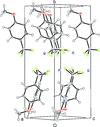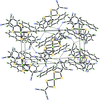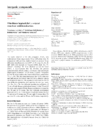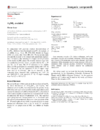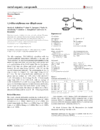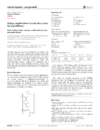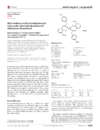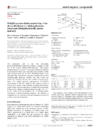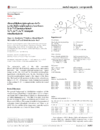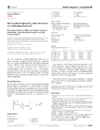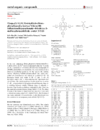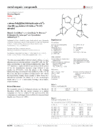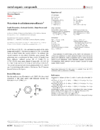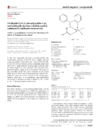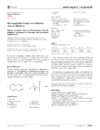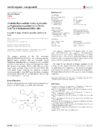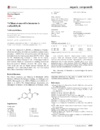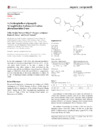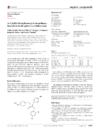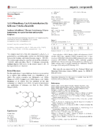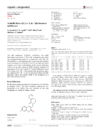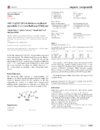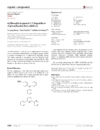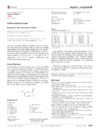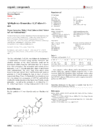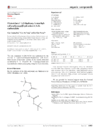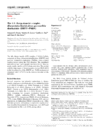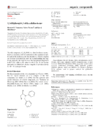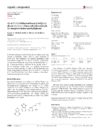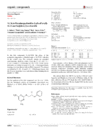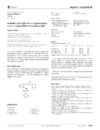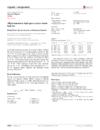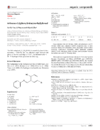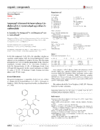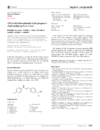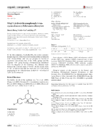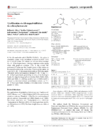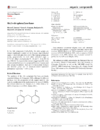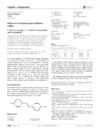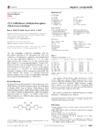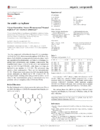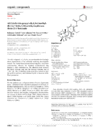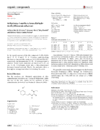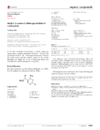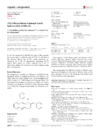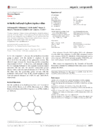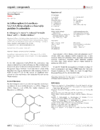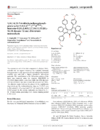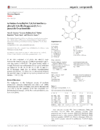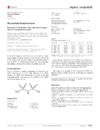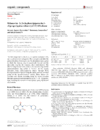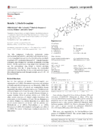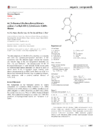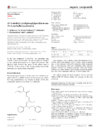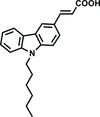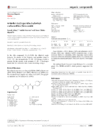issue contents
August 2014 issue

Cover illustration: {[Fe(H2O)2{Ag(CN)2}2](2,2'-bpe)2}n forms a two-dimensional grid-type structure with the organic guest molecules occupying the space between adjacent grid layers. The grid layers are held together by hydrogen bonds between the organic guest molecules and the host framework and gives rise to a three-dimensional supramolecular architecture. See: Othong, Wannarit, Pakawatchai & Youngme [Acta Cryst. (2014). E70, 107-110].
editorial
research communications
Download citation


Download citation


The structure of a hydroacridine with significant pharmaceutical potential is reported. The acridinone ring system is in the shape of a shallow V with the majority of the ring system substituents on its convex surface; a plethora of classical and non-classical hydrogen bonds stack the molecules into interconnected columns.
CCDC reference: 1004259
Download citation


Download citation


The crystal structure of [NiHg(SCN)4(CH3OH)2]n is made up of HgS4 tetrahedra and trans-NiN4O2 octahedra, linked together by thiocyanato bridges. The methanol molecules point to the cavities of the resulting framework.
CCDC reference: 1004260
Download citation


Download citation


The title molecule crystallizes with two half-molecules in the asymmetric unit, the whole molecules being generated by twofold rotation symmetry. In the crystal, there are two interpenetrating three-dimensional networks involving the individual molecules that are linked by C—H⋯Br and Br⋯Br interactions.
CCDC reference: 1004263
Download citation


Download citation


The crystal structures of the 1.5- and 10-hydrates of Na2SeO4 are isotypic with those of the corresponding chromates.
Download citation


Download citation


Molecules in both polymorphs of the title compound display deviations from planarity owing to crystal packing effects.
CCDC reference: 1004278
Download citation


Download citation


The title symmetrical steroid oxalate diester is substantially twisted about the central O2C—CO2 bond, leading to an overall shallow V-shape for the molecule, which may correlate with its reactivity under flash vacuum pyrolysis. C—H⋯O hydrogen bonds help to establish the packing.
CCDC reference: 1004276
Download citation


Download citation


The central ternary N atoms in the isotypic crystal structures of the substituted anilines show no sign of pyramidalization.
Download citation


Download citation


Despite their different compositions and space groups, the irregular KF8 coordination polyhedra of the potassium cations in these structures are almost identical. The layer stacking sequences are AAA… in the p-methoxy compound and ABAB… in the p-fluoro compound.
Download citation


Download citation


The title compounds are iron(II) dihalide complexes of the bulky arylimidazole ligand 1-(2,6-diisopropylphenyl)-1H-imidazole. The FeCl2 and FeBr2 complexes are isotypic, while the third compound, also an FeBr2 complex, crystallizes as a diethyl ether disolvate.
Download citation


Download citation


Crystal structure of trans-1,4-bis[(trimethylsilyl)oxy]cyclohexa-2,5-diene-1,4-dicarbonitrile
The molecular structure of the title compound is centrosymmetric. The cyclohexa-2,5-diene moiety is exactly planar and has a bond-length distribution characteristic for one pair of double bonds and two pairs of single bonds.
CCDC reference: 1008752
Download citation


Download citation


[Cd(C15H18N2)2(H2O)2](ClO4)2·C15H18N2·C2H6O, is a layered coordination polymer containing highly squashed 44 nets. The polymeric sheets alternate with layers of counter ions, free ligands and solvent molecules.
CCDC reference: 1008978
Download citation


Download citation


The planar pyrazolidine ring occurs in the betaine form with a Z conformation of the exocyclic C=N bond. In the crystal, C—H⋯O and C—H⋯π interactions result in the formation of ribbons of molecules along [1 0].
0].
CCDC reference: 1006910
Download citation


Download citation


The SnIV atom in the title compound shows a slightly distorted pentagonal–bipyramidal SnC2O5 coordination with the C atoms of the aliphatic chain in the axial positions.
CCDC reference: 1011391
Download citation


Download citation


In the mononuclear complex title salt, all of the non-H atoms of the cation lie on a mirror plane, as do the N and one O atom of the nitrate anion, such that the planes of the cation and anion are mutually orthogonal. In the crystal, layers parallel to (010) are generated by N—H⋯O hydrogen bonds, supported by short S⋯O [3.196 (4) and 3.038 (3) Å] and S⋯S contacts [3.4392 (13) Å].
CCDC reference: 1011568
Download citation


Download citation


The title compounds, (I) and (II), are dispiro-indole-pyrrolidine-benzothiophene derivatives, with (II) having a chlorine substituent on the oxoindole unit. As a result, the conformation of the two molecules differs in the angle of inclination of the indole moiety with respect to the benzothiophene ring system, with a dihedral angle of 71.59 (5) in (I) and 82.27 (7)° in (II).
Download citation


Download citation


The crystal structure of Cs2[Th(NO3)6] can be derived from a dense packing of idealized CsO12 and ThO12 units. The CsO12 units form a distorted hcp arrangement with half of the octahedral sites occupied by ThO12 units.
CCDC reference: 1012751
Download citation


Download citation


Crystal structure of a NiII–thiosemicarbazone complex showing an unusual cis arrangement of the N,S-donor ligands and anagostic C—H⋯Ni interactions.
CCDC reference: 1013220
Download citation


Download citation


The NiII atom in the title compound shows a square-planar NiN2O2 coordination with the imine N and phenolate O atoms of the two Schiff base ligands. C—H⋯O and C—H⋯π interactions result in the formation of sheets of molecules parallel to the ac plane.
CCDC reference: 1014286
Download citation


Download citation


{[Fe(H2O)2{Ag(CN)2}2](2,2′-bpe)2}n forms a two-dimensional grid-type structure with the organic guest molecules occupying the space between adjacent grid layers. The grid layers are held together by hydrogen bonds between the organic guest molecules and the host framework and gives rise to a three-dimensional supramolecular architecture.
CCDC reference: 1013775
Download citation


Download citation


1-Carbamoylguanidinium bis(2,4,6-trinitrophenyl)amide (= guanylurea dipicrylamide) builds up an array of mutually linked guanylurea cations and dipicrylamide anions. The crystal packing is dominated by an extensive network of N—H⋯O hydrogen bonds, resulting in a high density of 1.795 Mg m−3 which makes the title compound a potential secondary explosive.
CCDC reference: 1015895
Download citation


Download citation


In the ion-pair complex, bis[1-(naphthalen-1-ylmethyl)pyridinium] bis(2,2-dicyanoethene-1,1-dithiolate-κ2S,S′)nickelate(II), C—H⋯N and C—H⋯Ni hydrogen bonds as well as π–π interactions between the ions result in the formation of a three-dimensional network.
CCDC reference: 1015644
inorganic compounds
Download citation


Download citation


Download citation


Download citation


metal-organic compounds
Download citation


Download citation


Download citation


Download citation


Download citation


Download citation


Download citation


Download citation


Download citation


Download citation


Download citation


Download citation


Download citation


Download citation


Download citation


Download citation


Download citation


Download citation


Download citation


Download citation


Download citation


Download citation


Download citation


Download citation


Download citation


Download citation


organic compounds
Download citation


Download citation


Download citation


Download citation


Download citation


Download citation


Download citation


Download citation


Download citation


Download citation


Download citation


Download citation


Download citation


Download citation


Download citation


Download citation


Download citation


Download citation


Download citation


Download citation


Download citation


Download citation


Download citation


Download citation


Download citation


Download citation


Download citation


Download citation


Download citation


Download citation


Download citation


Download citation


Download citation


Download citation


Download citation


Download citation


Download citation


Download citation


Download citation


Download citation


Download citation


Download citation


Download citation


Download citation


Download citation


Download citation


Download citation


Download citation


Download citation


Download citation


Download citation


Download citation


Download citation


Download citation


Download citation


Download citation


Download citation


Download citation


Download citation


Download citation


Download citation


Download citation


Download citation


Download citation


Download citation


Download citation


Download citation


Download citation


Download citation


Download citation


Download citation


Download citation


Download citation


Download citation


Download citation


Download citation


Download citation


Download citation


Download citation


Download citation


Download citation


Download citation


Download citation


Download citation


Download citation


Download citation




 journal menu
journal menu



















